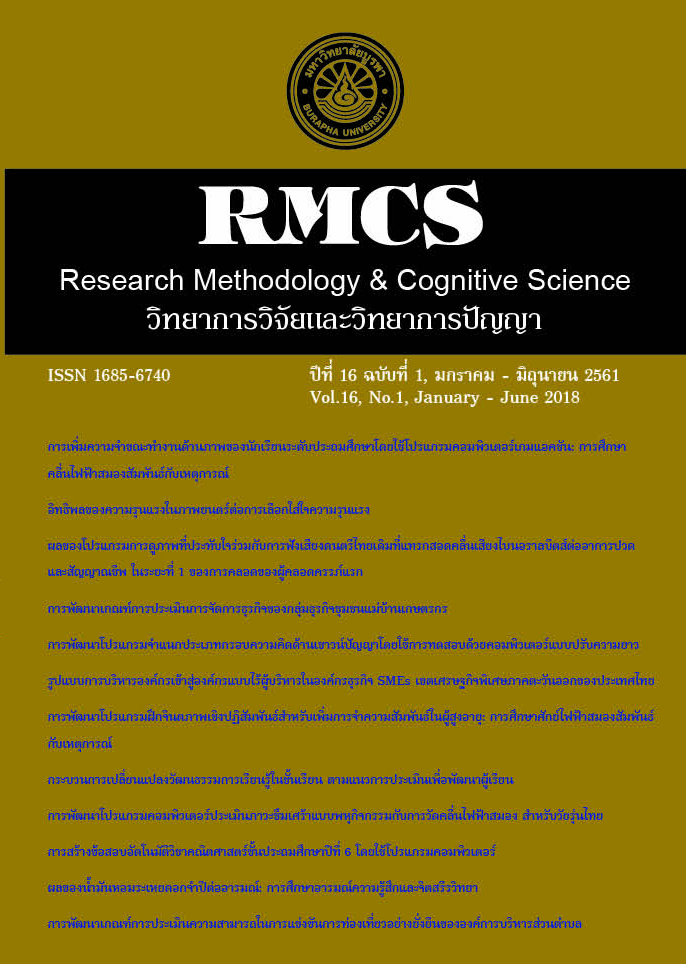Development of the Interactive Imagery Training Program for Increasing Associative Memory in the Elderly: An Event-Related Potential Study
Main Article Content
Abstract
The objectives of this research were to develop an interactive imagery training program for increasing associative memory in the elderly, and to compare its effectiveness on the correct response to face and name, as measured by: the average associative recognition memory index; and the mean magnitude of old/new effect after stimulus durations of 300 - 500 milliseconds (ms), and 500 - 700 ms. Participants were 44 adults, aged between 60 - 75, from the senior citizen club
of Nongsano Subdistrict Admintrative Organization Phetchaburi. They were randomly assigned to experimental and control groups with the same number of participants in each group. The research instruments were an interactive imagery training program, face-name associative recognition task, and the Neuroscan system. The data were analyzed by using repeated measures ANOVA.
The results showed that:
1. The associative recognition memory of the experimental group after training with the program evidenced a higher average of correct response to associative memory index when compared to before training, and also when to the control group (p< .05).
2. The mean magnitude of old/new effect of the experimental group after training with the program was higher than before training during the 500 - 700 ms at Frontal, Central, and during 500 - 700 ms at Frontal, Central, Temporal, Parietal, and Occipital (p< .05).
3. The mean magnitude of old/new effect of the experimental group after training with the program was higher than the control group during 500 - 700 ms at Frontal, Central, during 500 - 700 msat Frontal, Central, Temporal, Parietal, and Occipital (p< .05).
The results indicate that it may be concluded that the interactive imagery training program was capable of enhancing the associative memory of the elderly.
Article Details
References
Chu, O. (2008). Effectiveness of techniques for the learning of face-name associations. Master thesis, Faculty of Graduate Studies, Department of Psychology, University of Windsor, Canada.
Cohen, J. (1988). Statistical Power Analysis for the Behavioral Sciences(2nd ed.). New Jersey: Lawrence Erlbaum Associates.
Cohen, G. (1990). Why is it difficult to put names to faces?. British Journal of Psychology, 81(3), 287-297.
Cohen, G., & Burke, D. M. (1993). Memory for proper names: A review. Memory, 1(4), 249-263.
Delis, D. C., Lucus, J. A., & Kopelman, M. D. (2000). Memory. In B. S. Fogel, R. B., Schiffer & S. M. Rao (Eds.). Synopsis of Neuropsychiatry. (pp.169-191).
Philadelphia: Lippincott Williams & Wilkins.
Donaldson, D. I., & Rugg, M. D. (1999). Event-related potential studies of associative recognition and recall: Electrophysiological evidence for context
dependent retrieval processes. Brain Research, Cognitive Brain Research, 8(1), 1-16.
Duangchan, C., & Chadcham, S. (2013). An eventrelated brain potentials evidence for the effect of interactive imagery on face-name associative recognition in elderly. Research Methodology & Cognitive Science, 11(2), 1-15.
Edmonds, W. A., & Kennedy, T. D. (2017). An applied reference guide to research designs: Quantitative, qualitative, and mixed methods(2nd ed.). Thousand Oaks, California: Sage.
Goldstein, E. B. (2011). Cognitive Psychology: Connecting Mind, Research and Everyday Experience(3rd ed.). Belmont: Thomson Wadsworth.
Greve, A., Van Rossum, M., & Donaldson, D. I. (2007). Investigating the functional interaction between semantic and episodic memory: Convergent
behavioral and electrophysiological evidence for the role of familiarity. NeuroImage, 34(2), 801-814.
Groninger, L. D. (2000). Face-name mediated learning and long-term retention: The role of images and imagery processes. The American Journal of Psychology, 113(2), 199-219.
Heerema, E. (2017). Try these 9 Types of Mnemonics to Improve Your Memory. Retrieved September 24, 2017, from https://www.verywell.com/memorytip-1-keyword-mnemonics-98466.
Henke, K. (2010). A model for memory systems based on processing modes rather than consciousness. Nature Reviews Neuroscience, 11(7), 523-532.
Hockley, W. E. (1992). Item versus associative information: Further comparisons of forgetting rates. Journal of Experimental Psychology Learning Memory
and Cognition, 18, 1321-1330.
MacKenzie, G., & Donaldson, D. I. (2009). Examining the neural basis of episodic memory: ERP evidence that faces are recollected differently from names.
Neuropsychologia, 47(13), 2756-2765.
Mayer, R. E. (2001). Multimedia learning. New York: Cambridge University Press.
Mayes, A. R., Holdstock, J. S., Isaac, C. L., Montaldi, D., Grigor, J, Gummer, A., Cariga, P., Downes, J. J., Tsivilis, D., Gaffan, D., Gong, Q., & Norman, K. A.
(2004). Associative recognition in a patient with selective hippocampal lesions and relatively normal item recognition. Hippocampus, 14(6), 763-784.
Miller, G. A. (1956). The magical number seven, plus or minus two: Some limits on our capacity for processing information. The Psychological Review,
63(2), 81-97.
Naveh-Benjamin, M. (2000) Adult age differences in memory performance: test of an associative deficit hypothesis. Journal of Experimental Psychology:
Learning, Memory, and Cognition, 26(5), 1170-1187.
Naveh-Benjamin, M., Guez, J., Kilb, A., & Reedy, S. (2004). The associative memory deficit of older adults: Further support using face-name associations.
Psychology and Aging, 19(3), 541-546.
O’Hara, R., Brooks III, J. O., Friedman, L., Schröde, C. M., Morgan, K. S., & Kraemer, H.C. (2007). Long-term effects of mnemonic training in community-dwelling
older adults. Journal of Psychiatric Research, 41(7), 585-590.
Paivio, A. (1969). Mental imagery and associative learning in memory. Psychology Review, 76, 241-263.
Rhodes, S. M., & Donaldson, D. I. (2008). Electrophysiological evidence for the effect of interactive imagery on episodic memory: Encouraging familiarity for nonunitized stimuli during associative recognition.
NeuroImage, 39(2), 873-884. Robinson-Riegler, G., & Robinson-Riegler, B. (2009). Cognitive Psychology: Applying the Science of the Mind(2nd ed.). Boston: Pearson Education.
Sperling, R. A., Bates, J. F., Cocchiarella, A. J., Schacter, D. L., Rosen, B. R., & Albert, M. S. (2001). Encoding novel face-name associations: A functional MRI study. Human Brain Mapping,14, 129-139.
Troyer, A. K., D’Souza, N. A. Vandermorris, S., & Murphy, K. A. (2011). Age-related differences in associative memory depend on the types of associations
that are formed. Aging, Neuropsychology, and Cognition, 18(3), 340-352.
Yonelinas, A. P. (2002). The nature of recollection and familiarity: A review of 30 years of research. Journal of Memory and Language, 46(3), 441-517.

